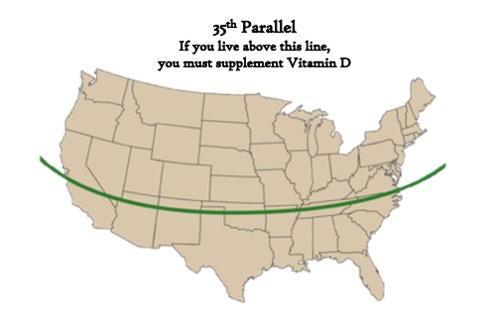During the winter months, low Vitamin D is associated with much higher risk of disease, especially viruses. Vitamin D is critical in protecting immunity, and most of us are extremely deficient in this vitamin. Now is the Fall season, so I’m posting an article about it by one of my favorite MD’s, Dr. Christiane Northrup:
 Why You Need Vitamin D
Why You Need Vitamin D
“Vitamin D is necessary for the health of every cell in your body. Yet, vitamin D deficiency has reached epidemic proportions. Overall, vitamin D influences more than 200 genes, each of which has the propensity to become impaired without adequate vitamin D. According to a number of studies, vitamin D deficiency can result in many diseases and conditions, including obesity, diabetes, hypertension, depression, rheumatoid arthritis, fibromyalgia, chronic fatigue syndrome, osteoporosis, Alzheimer’s disease, and cancers of the breast, prostate, and colon.
Yet, maintaining an optimal level of vitamin D can improve your immune system function and prevent many diseases, including colds and flu, cancer, and “autoimmune” diseases. Plus, an optimal level of vitamin D can improve your mood, regulate insulin, support heart and lung function, protect your brain from toxic chemicals, and may help reduce pain in people with chronic pain conditions.
Know the Risk Factors for Vitamin D Deficiency?
The average vitamin D level for all women in the US is 29 ng/ml—well below the recommended 40 ng/ml. For African Americans, the average is even lower—21 ng/ml. Typically, people who are vitamin D deficient do not know it because symptoms are subtle and often attributed to other conditions. The problem is, some of the symptoms of vitamin D deficiency can be serious. They include getting sick frequently, experiencing fatigue, chronic fatigue syndrome, bone pain, muscle pain, back pain, fibromyalgia, hair loss, depression, and poor wound healing. If you suffer from any of these symptoms, I recommend that you test your vitamin D levels.
But many people who don’t have symptoms are at risk for vitamin D deficiency. If you live in a climate where you do not get enough sunshine (such as above the 35th parallel), your stores of vitamin D most likely will be low, at least from November through March. Also, if you have dark skin, you are more likely to be deficient in vitamin D because melanin reduces your skin’s ability to synthesize vitamin D from sunlight.
Other individuals who are at greater risk for vitamin D deficiency include women who cover themselves from head to toe, such as women who wear burqas or niq?bs for religious reasons. Also, people who use SPF 30 or higher are at greater risk because sunscreen reduces your body’s ability to synthesize vitamin D by 95%! Plus, people who work the night shift (and sleep during the day) and people who are homebound are at greater risk of vitamin D deficiency. Office workers and people who live in highly polluted areas often have lower vitamin D levels. So do vegetarians and vegans. Finally, infants who are solely breastfed can develop low vitamin D levels and should receive 400 IU per day of an oral vitamin D supplement. (You can get drops made specifically for babies.)
Vitamin D and Breast Cancer Prevention
There are many studies that show the connection between vitamin D and breast cancer prevention. Reduction in risk can range from 55% to as high as 80%, depending on vitamin D levels. And, it appears the higher your serum vitamin D, the better in terms of preventing cancer.
In addition, much research shows that vitamin D is extremely important for regulating cell growth. This is very exciting news because not only do adequate vitamin D levels in women appear to reduce the risk of breast cancer up to 80%, some studies suggest that vitamin D may reduce the progression of cancer by slowing the growth of blood vessels within the cancer cells, thus causing cancer cell death and reducing the chance of cancer spreading (known as metastasis).
Even more exciting is the fact that vitamin D is associated with better survival rates among breast cancer patients. A 2014 statistical analysis performed by researchers at the University of California San Diego School of Medicine showed that vitamin D receptors are not lost until a tumor is very advanced. So, as long as vitamin D receptors are present, tumor growth can be prevented when vitamin D levels are adequate.
If you are concerned about your breast health or you have breast cancer, I recommend getting your vitamin D level tested and taking a high-quality vitamin D supplement to get your vitamin D level to around 60 ng/ml.
How to Test Your Vitamin D Levels
I recommend that everyone test their vitamin D levels. It’s good to do this when you are feeling well so you have a baseline. If you are having health problems, I definitely want you to get your vitamin D tested, especially if your symptoms are vague or if you suffer from a serious condition and are not improving with standard treatments.
Testing is easy, and you can do it from home with a home test kit. I like the ones from Grass Roots Health. If you are healthy and looking for your baseline measurement, start with the basic vitamin D test kit. You can also get one of the more comprehensive kits that allow you to test your omega-3 index, C-reactive protein (CRP), and A1c along with your vitamin D. You can also do a complete inflammation panel, which is good for people with chronic conditions.
Vitamin D tests are serum tests. This means that you will need to prick your finger. If that bothers you, then I suggest you ask your health care provider to perform a blood test to check your vitamin D levels. You should specifically ask to have a 25(OH)D test performed, also called a 25-hydroxy vitamin D. Be sure to get your actual number. Don’t settle for hearing that your vitamin D is “a little low” or that “you’re okay.”
Ideally, your vitamin D level should be at least 40 ng/ml—somewhere between 40–60 ng/ml is optimal. Higher levels are also fine up to approximately 100 ng/ml. If you are below 40 ng/ml, I suggest taking vitamin D supplements until you are in the ideal range. You can use the calculator on Grass Roots Health to determine the amount of vitamin D you need to take to reach your goal of 40–60ng/ml.
Other Ways to Increase Your Vitamin D Levels Naturally
If you are deficient in vitamin D, the best way to increase your serum levels is to take a high- quality supplement. However, there are two more ways you can increase your vitamin D levels naturally.
The first way to increase your vitamin D level is to spend more time outside in the sun. In order for your skin to synthesize vitamin D from the sun, you need to expose your skin directly to sunlight with no clothing barrier and no sunscreen. Soak in the sun for 5–10 minutes every day or until your skin turns slightly pink. If you have darker skin, you may need to stay outside a bit longer. I don’t recommend doing this when the sun is its hottest, but around 10:00 AM is usually a good time.
If you live in a climate where you cannot get adequate sun exposure during any part of the year, invest in a broad-spectrum light box. These produce the light you need—but without the UV rays—and are effective in helping your body synthesize vitamin D. Plus, light therapy can reduce symptoms of seasonal affective disorder(SAD), help you get a better night’s sleep, and reduce cravings for sweets and carbohydrates. Alaska Northern Lights makes good products, but there are many others on the market to choose from.
The second way to increase your vitamin D levels is by eating vitamin D–rich foods. These include fatty fish, such as cod, salmon, tuna, swordfish, sardines, and herring. Four ounces of cooked sockeye salmon contains roughly 596 IUs of vitamin D. But canned tuna in water contains only 68 IUs. So, you need to do your homework if you plan to get your vitamin D this way—and be committed to eating a lot of fish!
Fish oil is also a good source of vitamin D. For example, 1 tablespoon of cod liver oil contains about 1,360 IUs of vitamin D. So, if you take a fish oil supplement, be sure to take this into consideration when calculating how much additional vitamin D you need from a vitamin D supplement.
A couple of other foods also contain some beneficial vitamin D. Eggs (from chickens) contain about 44 IUs. And, 1 cup of maitake mushrooms contains 786 IUs of vitamin D. (Maitake mushrooms are also a good source of prebiotics and a great way to keep your microbiome healthy.)
How Vitamin D May Help Protect You from COVID-19
A systematic review and meta-analysis of 5 clinical trials shows that vitamin D plays an important role in reducing the rate and severity of acute respiratory tract infections, including influenza and COVID-19. The review study suggested that people with low levels of vitamin D who are at risk for these infections supplement with 10,000 IUs of vitamin D3 for several weeks, then drop down to 5,000 IUs as their levels rise. You should aim to raise concentrations of 25(OH)D above 40–60 ng/ml (100–150 nmol/l). If you are infected with COVID-19, you may need even higher doses of vitamin D3.
Another study shows that one way vitamin D appears to strengthen the immune system is by regulating cytokine production. Cytokines are inflammatory immunological proteins. Their job is to attack foreign invaders, such as viruses, so you stay healthy. However, in the case of COVID-19, we have heard some patients are experiencing what is called a “cytokine storm.” This happens when cytokines lose their ability to distinguish between foreign invaders and your own body. Supplementing to keep your vitamin D levels in the normal range may help to ensure your immune system is working properly and may help avoid complications from cytokine storms.
Have you checked your vitamin D level lately? Do you take vitamin D supplements?
“There’s no such thing as flu & cold season. There is only low Vitamin D season.” Dr. Ryan Cole
Hello, We are in Bali right now, enjoying the beautiful sunlight. Today I’m at the black sand beaches near our home at Keramas Sacred River Village on the Southeast coast. Sunlight is not a problem here, Yes, I get lots of sun, both direct and indirect.
Jane
Suggested Links:
- Dr. Ryan Cole Lecture, https://www.brighteon.com/473ac45d-2a8b-4eeb-a014-ef47d0ad791c
- Same video also on YouTube here: https://www.youtube.com/watch?v=vdrRGmoTYv4
- Over 200 Scientists & Doctors Call For Increased Vitamin D Use To Combat COVID-19, https://vitamind4all.org/letter.html?
- info [at] vitaminDforAll [dot] org
- COVID-19 Mortality Risk Correlates Inversely with Vitamin D3 Status, and a Mortality Rate Close to Zero Could Theoretically Be Achieved at 50 ng/mL 25(OH)D3, https://pubmed.ncbi.nlm.nih.gov/34684596/
- https://www.drnorthrup.com/why-you-need-vitamin-d/







2 Replies to "Are You Taking Your Vitamin D?"
Ayleyaell December 22, 2021 (5:11 am)
Which healthy vitamin D supplements do you recommend? Here in Washington state, I am definitely north of the 35th parallel!
Jane Barthelemy December 22, 2021 (5:24 am)
Hi Ayleyaell. Warm greetings to you. I hope you’re doing well! Vitamin D supplements vary widely. When I body douse the options in the store, I get crazy wild results indicating that some of them are terrible, and others are just barely OK. I’ve come to believe Vitamin D is also a question of individual compatibility. I can’t tell you which Vitamin D is best for YOU. You’ll need to research this. I can suggest you test them by holding the bottle at your solar plexus and body douse – notice if your body tends to move back and away, or does it move forward closer. Then go away and do something else for a few minutes. Then return a few minutes later and try again. You’ll get an answer. In the meantime, try to take a nice long walk outside every day. It will really help. Best wishes for your delicious health! Jane